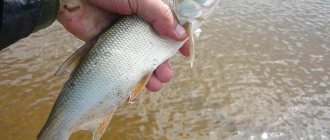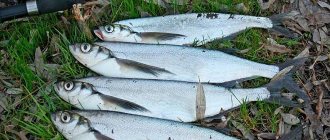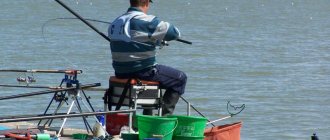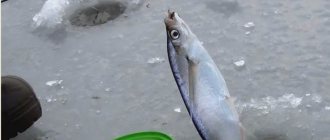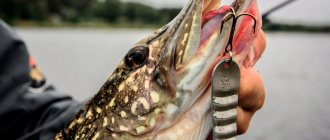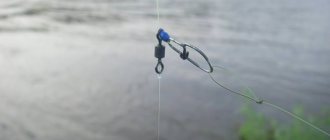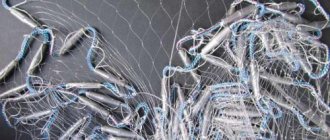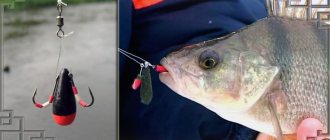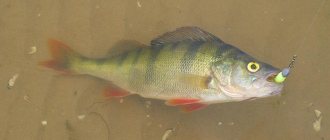Here’s the trick: the bite of sabrefish can clearly depend on the time of year, time of day, climatic features on a particular day; it can be caught either from the surface or from the bottom, or it can actively feed all day in the middle layers of water, which means There is a need to choose the right gear for successful fishing.
In addition, sometimes sabrefish bite perfectly from the shore (for example, many catch this fish from the pier), and sometimes you can only “get” it with a spinning cast or a donka (with a rubber shock absorber, a simpler name has taken root among fishermen - elastic), which you can put it at least 45-70 meters from the shore.
And if you have accurately determined that there is fish, selected tackle and bait, then saberfish will definitely be in your cage, since this fish is a schooling fish, and under favorable conditions for all participants in the process (in about an hour or two) you can catch several kilograms of this fish, which looks great dried or dried.
So, we have already decided that sabrefish are excellently caught from spring to autumn, only during the spawning period there is a certain lull in its biting. But after spawning, the fish “recovers” again, gradually returning to an active search for food and a standard lifestyle, delighting the fisherman with its bite.
What does the saberfish hunt for?
Like all carp fish, sabrefish feed all year round except during the spawning period. Its main diet consists of:
- phyto- and zooplankton;
- earth and water worms;
- larvae of various insects;
- insects;
- small crustaceans and molluscs;
- fish fry;
Being a non-predatory fish, after 3 years of age the sabrefish turns into a predator and begins to hunt small fish: bleak, perch, smelt, etc. The sabrefish feeds around the clock, constantly moving around the reservoir in schools and changing depth.
The best time to fish with a rubber band
You can use a bottom fishing rod with a shock absorber from spring to late autumn. But the best time is the pre-spawning period. The mating season for saberfish occurs at the end of May. However, in different regions, depending on natural features, it may shift somewhat in one direction or another. It is before spawning that the fish gather in large “shoals”. If a large flock is located near an established donkey, then several tens of kilograms of sabrefish can be caught in a day. During mating games, the biting stops for a short time. But already at the beginning of summer you can again continue the fascinating process of fishing with an elastic band.
Where to catch saberfish
Chekhon prefers to stay in open water. Her favorite places are:
- deep sections of rivers and reservoirs with slow flow;
- places of intersection of the main and reverse currents;
- small deep-sea creeks;
- pits with a rocky bottom or covered with driftwood;
- floodplains and flood lakes during spawning;
- river rapids;
- deep areas of lakes not covered with algae;
The choice of place for fishing largely depends on the time of year and day. The best bite for this voracious fish occurs in the spring before spawning. This time falls at the beginning of May, when, after winter stagnation, hungry flocks of saberfish emerge from the depths to the surface. During this period it can be caught in huge quantities. Staying away from the shore in areas free from algae, the fish is practically not afraid of anything, and if it starts to bite, the bite will continue until the last of the school is caught.
After spawning, the activity of saberfish slows down significantly, but does not stop. At dawn, at sunset and at night, she continues to peck all summer with average intensity, without changing her permanent habitats and her habits.
In the autumn , until the cold weather, the bite continues, but already at the first frost, the fish become numb and, having gathered in schools, go to winter.
But sometimes during thaws, sabrefish come out to hunt sedentary fry.
How to prepare a rubber donk for catching sabrefish?
So, let’s immediately note that the proposed tackle is affordable and can be easily prepared for fishing by an angler of any level. The main advantage of the gear is its compactness, which facilitates the transportation process. In addition, it is worth noting the high efficiency and ease of operation.
The main element of the tackle is an elastic band; its length is selected individually, it all depends on the distance at which the sabrefish will be caught. It is important to know that 1 m of elastic stretches by 2-3 meters, so for fishing at a distance of 30-35 meters it is enough to use 8-10 meters of fishing elastic. A meter of nylon cord is attached to one edge of the elastic through a plastic button, to which a load weighing 0.8-1.3 kg is fixed.
The elastic bottom is equipped with a fishing line with a cross-section of 0.3 mm; it is enough to wind 45-50 meters on the reel or spool of the reel. To make leashes, fishing line with a cross-section of 0.18 or 0.2 mm is used, the length of leashes is 15-20 cm, their number can reach up to 10 pieces. It is recommended to keep a distance of at least half a meter between leashes, but not more than 0.7 meters. Hooks No. 4-5 with a short shank and a sharp sting are attached to the leashes. The main fishing line is connected to the elastic band through a plastic button. It is not recommended to use metal rings for connections, since they quickly fray the fishing elastic.
Important! When choosing an elastic band, you should pay attention to its quality; the option under consideration must have a smooth and uniform surface; abrasions and roughness are not acceptable
It is more convenient to bring the tackle by boat; after the load is lowered to the bottom, at the required distance from the shore, the donkey is installed on the shore, in order to have time to notice bites in a timely manner, the fishing line should be passed through a stick 60-70 meters long, which is installed next to the donka. A piece of lead is attached to the main line; it is important to get some slack in the line.

For catching saberfish, various types of bait of animal origin are suitable: grasshoppers, worms, gadflies, maggots, large flies. If the choice is made on worms, then they should be placed in such a way that they do not hang from the hook by more than 3-5 mm. Large sabrefish can be caught with great success using fry.
The saberfish does not create any particular problems for the angler when fishing, but if the bite is not noticed in a timely manner, then most often the fish manages to quickly free itself from the hook. Therefore, as soon as the line begins to sag or tighten, you should make a sharp hook and immediately begin fishing. With a good bite, it is often possible to catch 3-4 fish at a time using an elastic band. It is recommended to store the caught fish in a cage, which is lowered into the water, preferably in a place where it is not exposed to direct sunlight.
Catching sabrefish is very interesting, since the fish is active almost throughout the daylight hours. Of course, early in the morning and late in the evening, bites occur more often and, as a rule, they are much more confident. Provided that it is possible to find a stopping place for sabrefish, the catch is guaranteed to be rich. The fisherman will not be bored on the shore; as soon as the hooks with baits are at the fishing points, the bite literally immediately follows. There are even cases when sabrefish bite occurs at the moment the tackle is released.
That's all. Happy fishing and good trophies!
What does the saberfish bite on?
Taking into account the omnivorous nature of sabrefish, you can catch it with almost anything – from maggots on a float rod to live bait or small silicone baits and twisters on a spinning rod. It happens that this fish bites on a bare hook tied with red thread. The most preferred and popular baits when fishing for saberfish are:
- maggot
- red (dung) worm
- insects (grasshopper, dragonfly, large fly, bee)
- insect larvae and caterpillars
- juvenile fish
The best way to catch sabrefish is with maggots . Fly larvae attract fish with their smell and contrast well at depth. In addition, it is convenient to attach the maggot, and when biting, you can leave it for 2-3 casts without changing it. The dung worm is a universal bait, so it is also successfully used for catching saberfish.
In May, the first insects emerge, the larvae of which developed at the bottom. They make up a significant part of the sabrefish’s diet, so it pays special attention to any insects. It is better to use live bait as bait in late summer and autumn, when the fish begin to eat before wintering, and the number of insects has decreased significantly.
During the biting period, you can find saberfish in a wide variety of areas, most often these are the following places:
- Areas of fast and slow jets
- At places with differences in depth
- In places of rafting of timber and flooded snags
- Often overlooks sand spits and shallows, areas with aquatic vegetation
- During the period of mass flight of insects, saberfish comes to the shore (5-20 meters from the coastline) and feeds in the surface layers.
Chekhon is a cautious fish, so when fishing near the coastline or from a boat, you need to be as quiet as possible and not let the waves blow too much, although with active biting these nuances are often lost sight of.
So, we have already noticed that sabrefish can be successfully caught using a variety of gear, but we will briefly look at how to catch “saber fish” with an elastic band. In principle, a rubber band for sabrefish is not much different from a regular rubber band, which is designed for catching the same crucian carp, for example, but there are still differences.
The best tackle for catching sabrefish

It is precisely these places that the saberfish prefers for its hunting. In the spring , when saber fish eats everything, fishermen everywhere use a rubber band to catch it. Being a universal tackle, this donka is also used for catching crucian carp, roach, silver bream, perch and other freshwater fish. They say that our lazy fishermen came up with it so as not to constantly bother with throwing and pulling out gear. Nowhere in foreign publications about fishing is such gear described.
In essence, a rubber band is an ordinary donkey with the addition of a rubber shock absorber, which allows you to reel in the catch and change the bait without pulling out the main gear. A distinctive feature of this gear is its simplicity and ease of use. Even a beginner who has no idea about the rules of hooking and fishing for fish can catch fish with it.
Fishing with a rubber band: we make tackle for catching bream, crucian carp, sabrefish.
Catching carp - video review of fishing methods.
8 ways to put a bloodworm on a hook.
Donka with rubber shock absorber for sabrefish
The tackle is a three-part structure.
The first part is the stock of main line on the reel.
The second part is the undergrowth with leashes.
The third part is a rubber shock absorber that is attached to the load.
It is better to make all three parts removable, that is, use fasteners with swivels to connect them. This will help you quickly replace some parts. In addition, it is also better to store all parts of the gum separately. There will be less confusion when preparing the elastic band for fishing.
An elastic band is a bottom only if a sinker is attached to the undergrowth at the very beginning. Then you can catch any fish with a donkey with a rubber shock absorber, but most crucian carp are caught with such a rubber band in ponds. But for catching saberfish, loading gear is not required. This fish stays in the middle and surface layers of water. Therefore, the tackle looks the way it is presented in its classic form.
How to make an elastic band
The design of the elastic band is quite simple, so you can easily make it yourself. For this you will need:
- main line 0.3-0.35 mm thick, 40-50 m long;
- fishing line for leashes with a thickness of 0.25-0.3 mm;
- several swivels (for each leash);
- elastic band 15-25 m long;
- lead or other weight 0.5-1 kg with a swivel;
- a piece of strong rope (about 1 m for securing the load);
- set of hooks (5-6 pcs.) No. 6-8;
- winding rings or small carabiners (2 pcs each);
- electronic bite alarm or bell;
- Motviltse;
- large float or buoy (optional);
A piece of rope is tied to the load through a swivel. The ends of the elastic are formed into loops with a double knot, one of which is connected to the rope through a carabiner or winding ring, and the other is attached to the main fishing line through a swivel.
Next, leashes 30-50 cm long are made, onto which hooks are tied. On the working section of the main fishing line (5-6 m from the beginning, tied to the rope), 5-6 loops are made for attaching leashes, which are attached using the “loop-to-loop” method or through a swivel. The finished tackle is wound on a reel. If the leashes are tightly secured, it is recommended to put pieces of cambric or nipple rubber on the hooks to avoid unexpected snags and damage. But it is better to tie leashes to already abandoned tackle, extending the working part of the main fishing line.
Some fishermen additionally attach a safety line to the sinker. This helps to get it out if the rubber band breaks. Such insurance is thrown along with the main gear.
Elastic band diagram
The gear looks like this.
For rubber shock absorbers, durable round rubber is usually used. Sometimes they install double rubber, made from the same round rubber. This increases the strength of the shock absorber. The length of the rubber shock absorber usually does not exceed 10-12 meters . This is enough to transport cargo by boat 50-60 meters from the shore . Usually, as a safety net , the load is equipped with a buoy, so that if the rubber band breaks, the load can be lifted from the bottom and the tackle can be repaired. The elastic band is also equipped with a safety cord, which can be used to pull the load. But the tackle becomes more cumbersome. Therefore, a safety cord is more often used when throwing an elastic band from the shore by hand, that is, the load is thrown rather than brought in by boat. In this case, the location of the hooks will be much closer to the shore. And this method of throwing a load is more suitable for a small river and pond. In this case, the rubber shock absorber is shortened to 5 meters .
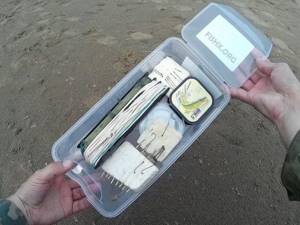
Fishing technique
There are two ways to install the rubber donut. If you have a boat, you can choose a promising place and accurately lower the load with the float. The distance is determined experimentally, since the stretching of the elastic depends on the quality of the material. It is possible to accurately cast the tackle from the shore after several trial attempts. The tackle is carefully laid out on a clean area of the shore, then the cord with the load is taken into the hand. After several swings, the tackle flies to the designated location. When the bottom is installed, you need to pull out the main line, attach the leaders and attach a different bait to each hook. After this, you can smoothly release the stretched line. When the first fish is caught, all hooks can be equipped with a priority bait for sabrefish. Tip: to activate the bite, it is better to hold the fishing line in your hand, periodically lifting or pulling the tackle. A bite is defined as catching an underwater obstacle. After this, frequent jerks of sabrefish are felt. A fish caught on a hook tries to go against the current, periodically jumping out of the water. It is often possible to pull 2-3 fish ashore at a time using an elastic band. Please note: in warm weather, to store fish, it is necessary to install a cage on the current. Otherwise, saberfish quickly fall asleep in captivity.
Fishing for crucian carp
Most often, crucian carp is caught using this type of gear. This is a cautious fish, but given the immobility of the bait and the entire structure, you can expect the first bite 10-15 minutes after casting. But for a good catch, you need to take into account the behavior of crucian carp.
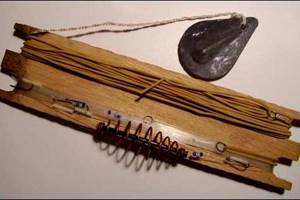
They are as follows:
- Bait. You can use bread, dough or porridge.
- Additionally, it is recommended to attach several filled feeder baits between the hooks. In this case, the tackle is transported to the desired location only by boat.
- To dissolve the bait in the water, you need to shake the rubber band periodically.
When bitten, you don’t need to hook immediately. The crucian carp may try the bait several times, and only after making sure that there is no danger will it swallow the bait.
The video shows the process of making a universal elastic band:
